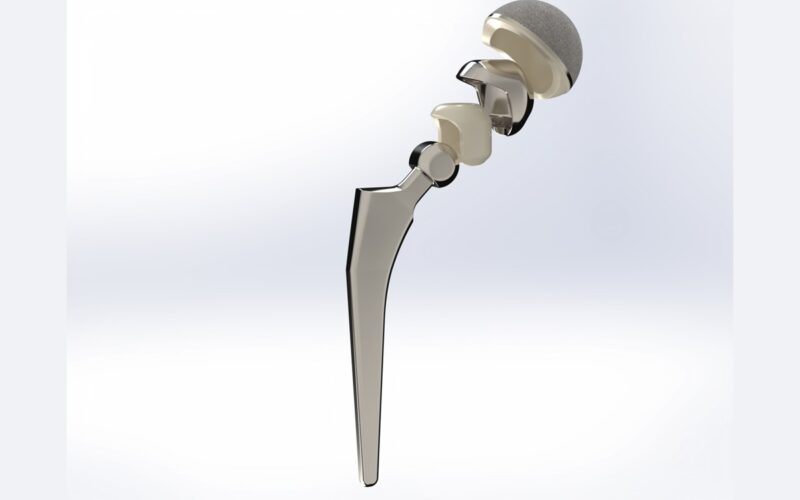From its inception, the MaltaHip project aimed to tackle challenges related to traditional hip implants, addressing the needs of millions with joint-related issues worldwide. Requiring an interdisciplinary approach, this project brought together a multifaceted team from the University of Malta, including Prof. Pierre Schembri-Wismayer, Prof. Ing. Pierluigi Mollicone, Prof. Ing. Joseph Buhagiar, Dr Ing. Donald Dalli, Dr Leonardo Fanton, and Prof. Ing. Bertram Mallia, who are now collaborating with UK-based Garland Surgical Ltd.
From lab to real-world readiness
Research fuels technology development, yet the path from research to market can be unclear without established criteria. Technology readiness levels (TRLs) – a ranking system originally developed by NASA to assist in evaluating and managing the progression of new technologies from concept to deployment – was designed to do just that.
MaltaHip has progressed to TRL 6 (refined prototype successfully tested in cadaveric implantation), but even reaching TRL 3 (university prototype testing) was no easy feat, explains Buhagiar, one of the MaltaHip inventors. The researchers had to design and build a custom machine that replicates all the movements of the hip joint while applying a variable load to simulate body weight. These initial wear-simulation tests were performed to ‘see if the sizing was correct, if the parts were moving correctly, and to identify any obvious problems,’ says Buhagiar. ‘As everything was functional, we could proceed to the next step.
Once it was clear that the proof-of-concept was viable, the UM research team – with the assistance of EMPAV Engineering Ltd, a Maltese manufacturing engineering workshop – produced additional prototype prostheses that met all the functional criteria for a hip replacement. This prototype was then sent to EndoLab® in Germany, a facility specialising in biomechanical testing. There, MaltaHip surpassed expectations. Following simulations mimicking millions of gait cycles (the cyclic pattern of movement that occurs while walking), the device exhibited significantly less wear than traditional commercial hip implants. In fact, in some cases, the wear was too minimal to measure. This result alone demonstrated that the prosthesis could handle high loads without degradation, while also suggesting longer-lasting use – a factor that could redefine standards in orthopaedic care. At this time, MaltaHip was no longer just an innovative concept.
What are the next steps?
‘We incorporated Garland Surgical Ltd to further develop what was a promising proof-of-concept project into a commercially viable hip replacement system. We raised initial funding of around €1.5 million to further develop the implant design into a device that would suit a global population – addressing the three key limitations of the existing available implants: namely, reduction of wear, stability, and range of motion,’ explains Simon Mifsud, CEO of Garland Surgical Ltd.
‘Now that we’ve completed the initial verification of the latest prototype, we are raising more funds to complete product development. This will allow us to complete something called the design history file – organised documentation of all the product design and development processes – and then begin the regulatory clearance needed to sell it worldwide.’

A smarter design, proven by science
What explains the exceptional wear resistance at the heart of MaltaHip’s novel design? A considerable difference from all of the traditional hip replacements, which simulate the ball-and-socket nature of the human joint, lies in ‘the molecular behaviour of the used polymeric materials in the prosthetics,’ says Schembri-Wismayer. Unlike current implants on the market, the unidirectional curvilinear articulations of the MaltaHip allow the molecular chains in the polymer components to align in a single direction under pressure. This alignment reduces a common phenomenon known as ‘cross-shear’ and significantly improves resistance to degradation.
‘Due to its design, the MaltaHip prosthetic cannot be dislocated easily. That means the patient is able to perform daily activities like tying a shoelace, sitting cross-legged, or swinging their affected leg out of bed without dislocating their hip after surgery. These are things we all take for granted. They will also be able to pursue their interests, whether that’s playing tennis, practising yoga or surfing; they can feel confident in their implant,’ Mifsud points out. By offering greater longevity and a lower risk of failure, MaltaHip provides a viable option for younger patients who want to reclaim their mobility and quality of life early – without sacrificing long-term outcomes.
The Team also highlighted a final point about the device’s long-term value. Culturally, certain ethnicities require a larger range of motion than others – for example, some Asian and Middle Eastern populations sit cross-legged or in a squatting position to socialise or pray. With a standard hip replacement, this can be risky. ‘With our device, we believe they will be able to do that. This device has been designed to suit a global population, addressing a lot of the current health inequalities in hip replacements,’ Mifsud notes.
MaltaHip is not just an invention – it is a reinvention of what orthopaedic medicine can achieve. With its roots firmly planted in research from the University of Malta and its branches reaching into global markets, it offers a rare fusion of innovation, inclusivity, and impact. As Garland Surgical Ltd advances clinical and commercial development, the MaltaHip project may well become one of the island’s most remarkable contributions to global health.
Read more about the conception of the MaltaHip Project on THINK’s website here.
This is an abridged version of an article by Inês Ventura features in Issue 47: Disciplines of THINK Magazine, the official research magazine of the University of Malta. For more articles from the edition, pick up a copy on Campus or read here. (Republished courtesy of THINK).










